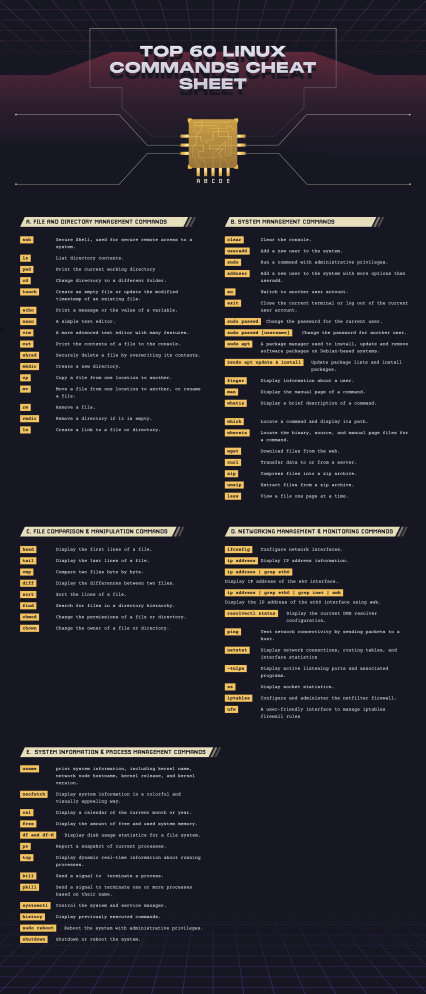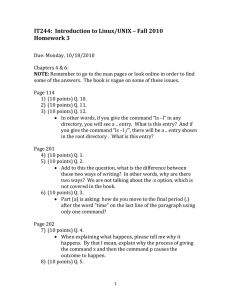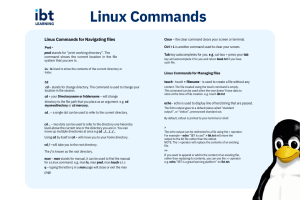
Top 60 Linux Commands Cheat Sheet a BCDE a. File and Directory Management COMMANDS ssh ls pwd cd touch echo nano vim cat shred mkdir cp mv rm rmdir ln Secure Shell, used for secure remote access to a system. List directory contents. Print the current working directory Change directory to a different folder. Create an empty file or update the modified timestamp of an existing file. Print a message or the value of a variable. A simple text editor. A more advanced text editor with many features. Print the contents of a file to the console. Securely delete a file by overwriting its contents. Create a new directory. Copy a file from one location to another. Move a file from one location to another, or rename a file. Remove a file. Remove a directory if it is empty. Create a link to a file or directory. B. SYSTEM MANAGEMENT COMMANDS clear useradd sudo adduser Clear the console. Add a new user to the system. Run a commend with administrative privileges. Add a new user to the system with more options than useradd. su Switch to another user account. exit Close the current terminal or log out of the current user account. sudo passwd Change the password for the current user. Change the password for another user. sudo passwd [username] sudo apt A package manager used to install, update and remove software packages on Debian-based systems. 2sudo apt update & install Update package lists and install packages. finger Display information about a user. man Display the manual page of a command. whatis Display a brief description of a command. which whereis wget curl zip unzip less C. File Comparison & Manipulation COMMANDS head tail cmp diff sort find chmod chown E. Display the first lines of a file. Display the last lines of a file. Compare two files byte by byte. Display the differences between two files. Sort the lines of a file. Search for files in a directory hierarchy. Change the permissions of a file or directory. Change the owner of a file or directory. system Information & Process Management COMMANDS uname print system information, including kernel name, network node hostname, kernel release, and kernel version. neofetch Display system information in a colorful and visually appealing way. cal Display a calendar of the current month or year. free Display the amount of free and used system memory. df and df-H Display disk usage statistics for a file system. ps Report a snapshot of current processes. Display dynamic real-time information about running top processes. kill Send a signal to terminate a process. pkill Send a signal to terminate one or more processes based on their name. systemctl Control the system and service manager. history Display previously executed commands. sudo reboot Reboot the system with administrative privileges. shutdown Shutdown or reboot the system. Locate a command and display its path. Locate the binary, source, and manual page files for a command. Download files from the web. Transfer data to or from a server. Compress files into a zip archive. Extract files from a zip archive. View a file one page at a time. D. networking management & Monitoring COMMANDS ifconfig Configure network interfaces. ip address Display IP address information. ip address | grep eth0 Display IP address of the eh0 interface. ip address | grep eth0 | grep inet | awk Display the IP address of the eth0 interface using awk. resolvectl status Display the current DNS resolver configuration. Test network connectivity by sending packets to a ping host. netstat Display network connections, routing tables, and interface statistics -tulpn Display active listening ports and associated programs. ss Display socket statistics. iptables Configure and administer the netfilter firewall. ufw A user-friendly interface to manage iptables firewall rules

